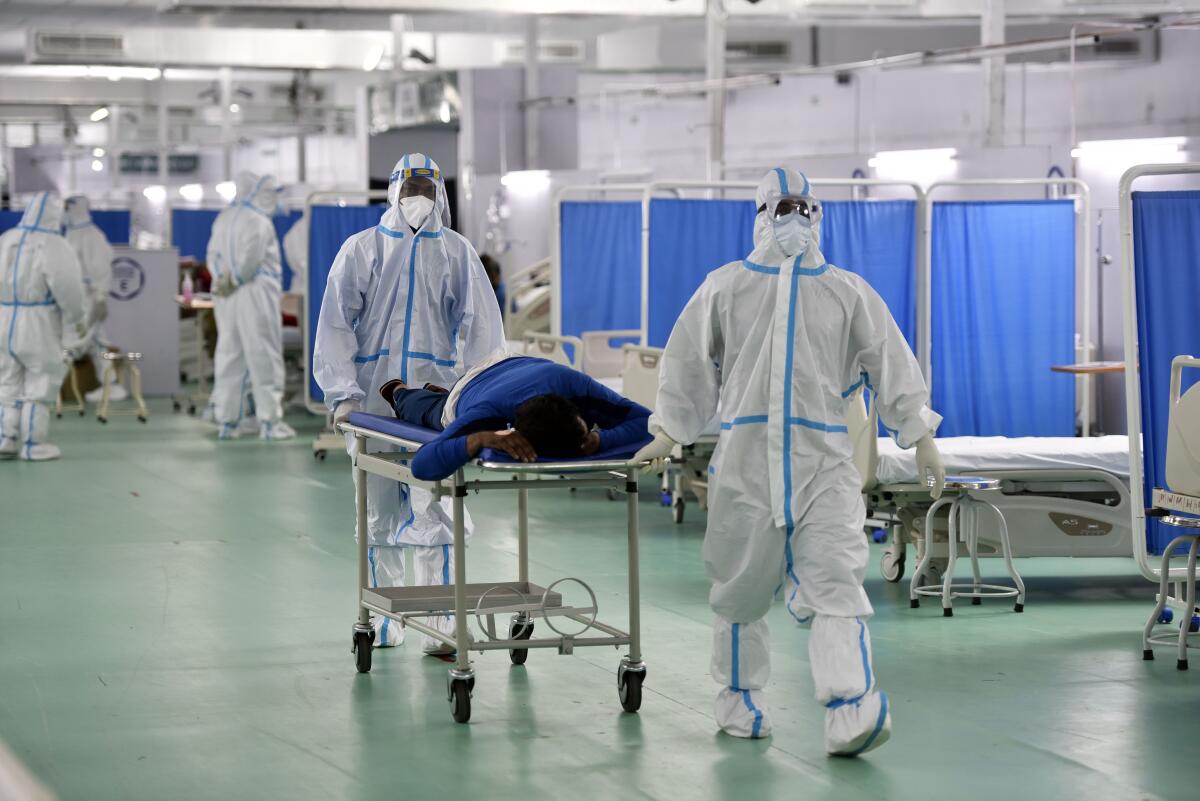The ‘double mutant’ coronavirus variant in India may be less scary than it might seem

- Share via
The so-called “double mutant” variant first identified in India can sound frightening at first glance.
But as more data are studied, some scientists say India’s catastrophic COVID-19 surge this spring has less to do with this variant and more to do with the government’s premature lifting of pandemic rules too quickly when only a tiny fraction of India’s population had been vaccinated.
A number of scientists suspect the new variant, B.1.617, is not the central reason behind India’s catastrophic surge this spring.
Rather, it was the wholesale abandonment of the relatively successful lockdown policy that, last year, spared the nation from the kind of death toll India is experiencing now. Last year’s lockdown was damaging economically and politically, and poor urban areas — like the slums in Mumbai — were hit hard by the virus. But middle- and upper-class areas were spared last year, and political leaders marveled at what they called a success.
“The cases were so low, and it was going so well. And no one was in the hospital with COVID. I mean, there was literally a time that New Delhi had two people in the hospital with COVID,” UC San Francisco infectious diseases expert Dr. Monica Gandhi said. “I know a lot of Indians, and they just stayed at home,” Gandhi said, with household work being done by paid workers.
Buoyed with confidence, the governing party claimed COVID-19 had been “defeated” under the leadership of Prime Minister Narendra Modi, and the health minister said India had reached the “endgame” of the disease. Masks were shed. Earlier this year, thousands returned to sports games and election rallies and millions celebrated the Hindu festival Kumbh Mela by taking dips in the sacred Ganges and Yamuna rivers.
Now, India is suffering through the worst COVID-19 surge any country has faced since the global pandemic began last year. Less than 10% of the population has been vaccinated.
Why did the ‘double mutant’ variant attract so much attention initially?
A newly identified coronavirus variant was identified in India at about the same time cases started surging there.
It was nicknamed the “double mutant” variant by the BBC and other news outlets because it contained two worrisome mutations in its genetic composition, which some scientists thought might cause reduced immunity in people who had been vaccinated or had survived a conventional COVID-19 illness.
What was the specific concern?
Ideally, when a virus enters the body of a person with immunity, the body generates a giant army of antibodies to attack the enemy invader, fending it off from being able to hijack human cells and reproduce itself in the body, eventually destroying the lungs.
Scientists worried that the B.1.617 variant would act like some of the other variants they worried about.
In the lab, scientists exposed the blood of people with immunity to variants. When reacting to some of the variants, the army of antibodies created to react to the invading variant was smaller compared with when a conventional coronavirus attacked.
That raised concerns about whether some variants could render vaccines less effective.
Still, there was some hope: Some studies showed that even though the number of antibodies produced was less against some variants, it was still enough to do a decent job.
Why are some scientists less concerned about the B.1.617 variant?
Data are actually showing vaccines being effective against the B.1.617 variant.
So what was wrong with the worrisome lab test?
The lab tests didn’t account for another important part of the body’s immune system response — T cells, another critical part of the immune system that is harder to test for in the lab, according to Gandhi.
T cells may end up being the hero of the immune response to some variants.
T cells are slower to respond to an invading virus, but when they do get into action, they can ward off severe disease and death, Gandhi said.
As a result, a subsequent immune response by T cells may end up coming to the rescue to prevent a deeper infection of the lungs, even if the initial immune response permits the virus to infect, say, the nose.
“That’s what T cells do: They prevent you from having severe disease,” Gandhi said.
So why are there some reports of fully vaccinated medical staff still getting sick with COVID-19?
When health officials say a vaccine is 90% effective, that means that 10% of the time it’s not effective, said Dr. George Rutherford, epidemiologist at UC San Francisco. The more people who are exposed to the coronavirus, the higher the number of so-called breakthrough infections.
“It may not have to do with variants as much as it just has to do with the intensity of the exposure,” Rutherford said.
Why does this matter?
Some people questioned why they needed to get immunizations if the shots would soon be superseded by something new.
The latest data provide assurance that we have vaccines that can probably be trusted to end the pandemic without worrying about variants rendering them ineffective, Gandhi said.
The challenge is getting the vaccines to everyone in the world who still needs them.
Times staff writer David Pierson in Singapore and special correspondent Parth M.N. in Mumbai contributed to this report.
More to Read
Sign up for Essential California
The most important California stories and recommendations in your inbox every morning.
You may occasionally receive promotional content from the Los Angeles Times.











